Disclosure: Meeple Mountain received a free copy of this product in exchange for an honest, unbiased review. This review is not intended to be an endorsement.
Disclaimer: The author of this review participated in playtesting of this design in mid-2022.
I don’t like combos. They have become a substitute for great game design. Can’t think of anything interesting to do? Slap some combos on there. Suddenly everyone is too busy saying “Weeeeeee!” to notice that this rollercoaster doesn’t actually do much. The last decade or so of The Hobby™ would indicate that I am in the minority on this, but I’m comfortable with that. Everyone should have at least one deeply-held harmless opinion that’s open to persecution. It’s good for you.
When I talk about “combos” in this instance, I don’t mean an immediate bonus. “Oh, and I get an extra wheat because I have the thresher.” No. I’m talking about a single action with the potential to turn into a cascading series of subsequent actions. “If I place this token here, then I can put that token there, which means that I can now move this marker up that track, which lets me put another token over here, which means I can,” and so on. Combos are deeply, primitively satisfying. I understand entirely why they are so popular. I myself enjoy them, even if I don’t like them. There is a difference.
To me, combos feel like a substitute for good decisions. I don’t need combos in Azul, or Beyond the Sun, or Tigris & Euphrates. The one or two actions I get each turn are interesting enough. The ramifications of placing a tile where I place it are significant in their own right, not because it allows me to then place another tile, or move up a track. That economy is great game design.
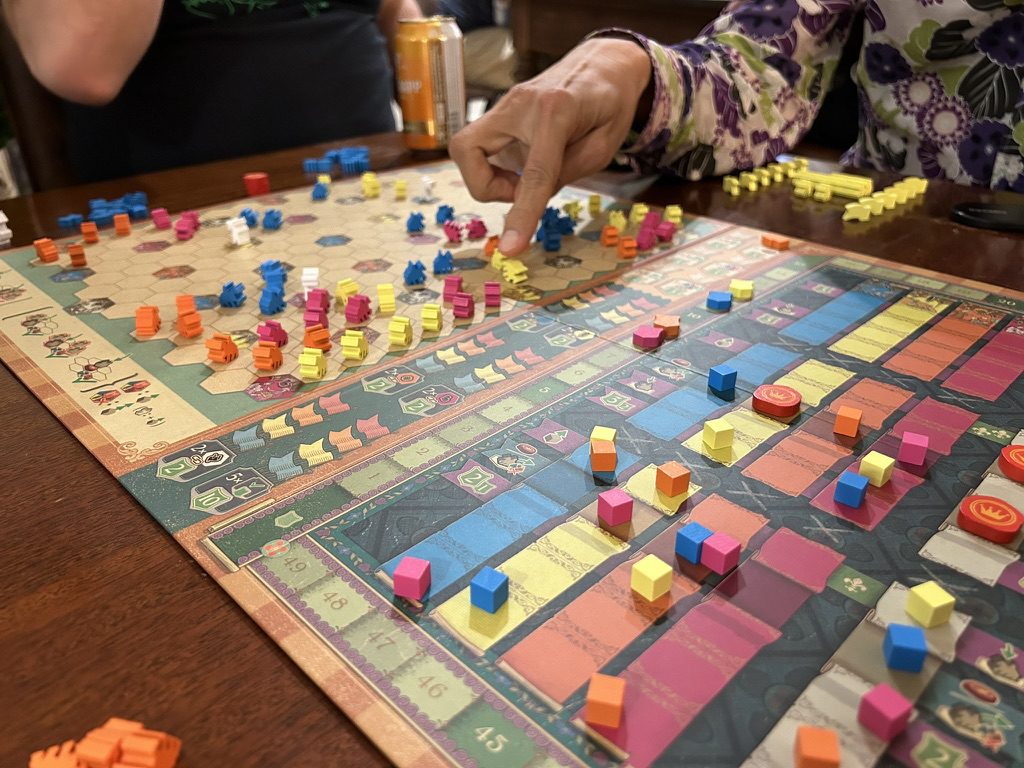
Combodero
Reiner Knizia, one of the greatest game designers to ever do the damn thing, has started to incorporate combos into his output over the last few years. Witchstone, Milli Fiori, and Lost Cities: Roll & Write leap to mind, but I’m sure there are others. These are, reliably, my least favorites of his games. Cascadero, the latest Knizia design from publisher Bitewing Games, is entirely about combos.
Despite that, I went into it with great excitement. It is, after all, a descendent of the classic Knizia tile-layers, kin to Tigris & Euphrates, Samurai, Stephenson’s Rocket, and Through the Desert. That is as strong a series of forebears as it’s possible to have. There will never come a day when I will not be happy to give a Knizia tile-layer a try.
In Cascadero, Knizia marries some of his time-honored tricks to a collection of tracks, which occupy the right half of the board. Every turn, you place one Envoy onto any available space, with the goal of linking groups of two or more envoys to the towns that pepper the Spanish countryside. Each time you do that, you move up one space on the track that corresponds to the color of the town.

The first Knizian wrinkle, and my favorite part of the game, presents itself here. If you connect a group to a new town, and you are the first envoy to reach that town, you move the corresponding cube one space up the track. If, on the other hand, a different group (be it yours or anyone else’s) has already established contact with that town, you move two spaces up the track. Nearly every space on each track has a bonus action connected to it, and many of those benefit the first player more than they benefit any subsequent players.
Several of the scoring spaces, for example, give more points to the first player to reach them, while each track also contains two-to-four Seals, which offer powerful bonuses to the players who collect them. A single Envoy, unaccompanied by a group, can use a Seal to score a town. That doesn’t sound like much, but in Cascadero, it is a big deal.
The other spaces on the tracks exist at the root of the combos. Some allow you to boost any cube one space up its track. Others allow you to take a second turn. These can be intensely satisfying, especially as you get a feel for what kinds of plays the game will reward, but it never quite works. Cascadero never transcends the mechanics of what you’re doing.
Oh, another (very Knizian) thing: you cannot win the game if you do not get to the top of the track that matches your player color. Theoretically, this could lead to all sorts of fascinating plays to block other players, but it is rarely in your interest to go out of your way in Cascadero. The benefits to messing with others are lower than the benefits to pursuing your own interests.
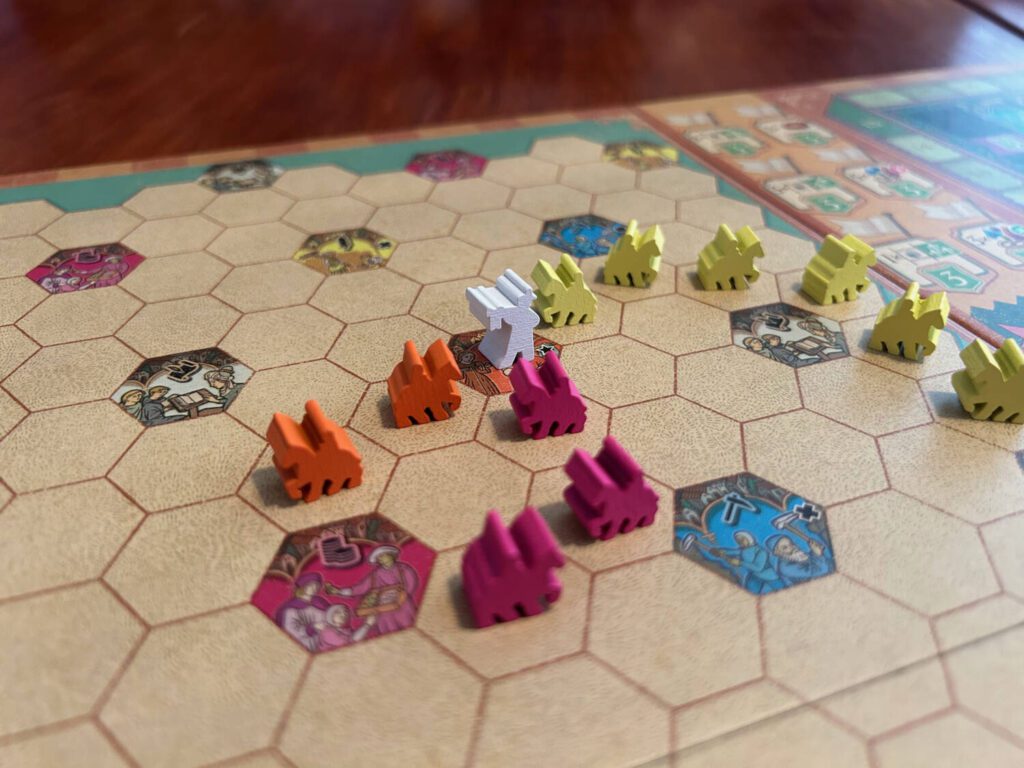
Missed Connections
The tracks interact with a group of achievements. Several of them can only be claimed by a single player. Others can be claimed by everyone, provided everyone is able to pull them off. The single-claimant spaces relate to the tracks. The first player to get above a certain threshold on three tracks, for example, or the first player to have three Seals in front of them. The others relate to the board. Connect two matching villages, or form a Rainbow Road that unites all five colors.
The game has three modes, and I certainly advocate playing the advanced one. There’s only one significant difference. Four towns at the beginning of the game play host to Heralds (Royal Messengers on the back of the box), who provide an additional cube’s worth of track movement to any and all groups that connect to them. In the advanced rules, there are only two Messengers, and they move to a neighboring town each time they’re activated. This creates, in my experience, a more dynamic board. There’s also a lot more swearing, which is as good a sign as any.
Talking about production choices in a review of any Bitewing release is starting to feel superfluous. The only other publisher who gives you the same value for money is Devir. Ian O’Toole has turned in such aesthetically pleasing work here that I almost regret ever referring to any other game as “handsome.” Bitewing also, to their absolute credit, continues to keep boxes exactly the size they need to be. Cascadero is slim, and for that I greatly appreciate it.
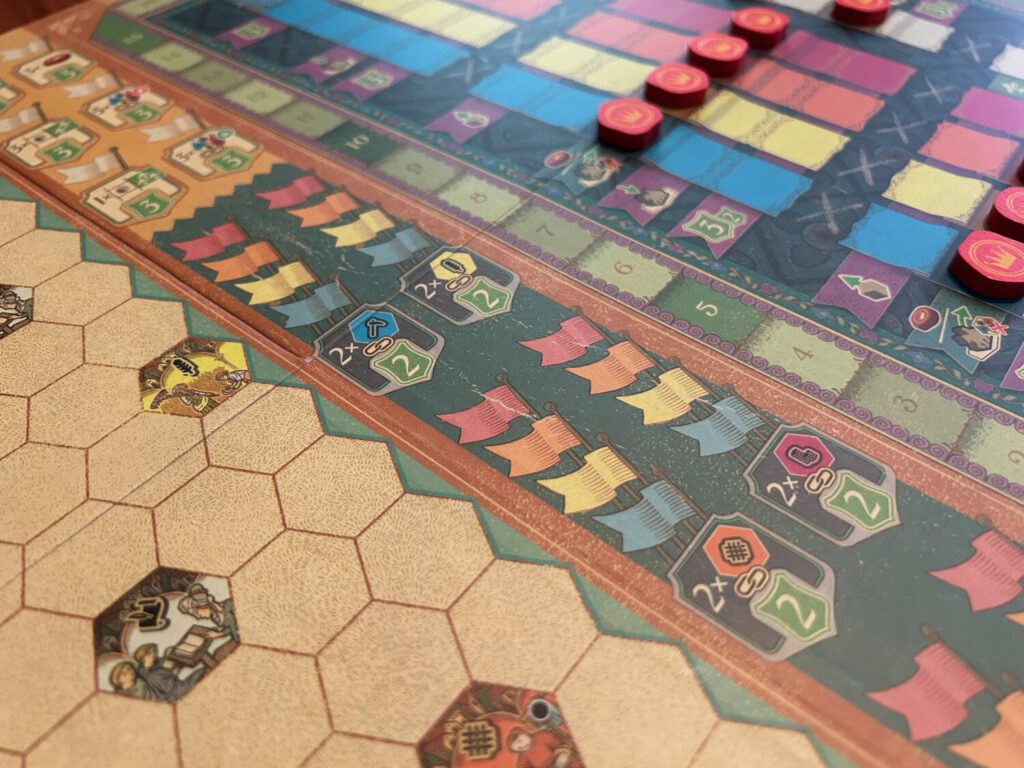
Cascadero isn’t bad, not by a long shot, but it’s also missing something. The decisions around placement don’t feel loaded enough. I rarely felt threatened in my games, and my fellow players reported much the same. Seldom did I feel like I had to make a tough choice between two options, which is exactly what I want out of a game like this. As I mentioned earlier, pressure is rarely applied, because there are few circumstances in which it is worth taking the time to apply it.
In the middle of the game, as players progress up the different tracks, turns can stretch on into surprisingly lengthy affairs. The problem with combos, even when playing with people who don’t suffer from AP, is that they transform nearly every turn into an agonizing quest for perfection and optimal execution. Cascadero promises a playtime of about 45-60 minutes, but it readily hits the 90 minute mark. It’s a double-bind; the game is designed to be fast and breezy, but it’s also designed to encourage combos. The execution of those combos keeps it from being fast and breezy.
Cascadero’s biggest issue? I’d rather play Tigris & Euphrates, Samurai, Stephenson’s Rocket, or Through the Desert. Each scratches a very different itch, but each scratches that particular itch better. No matter what part of Cascadero you like, I can tell you a Knizia game that does that thing better. Even the combos.


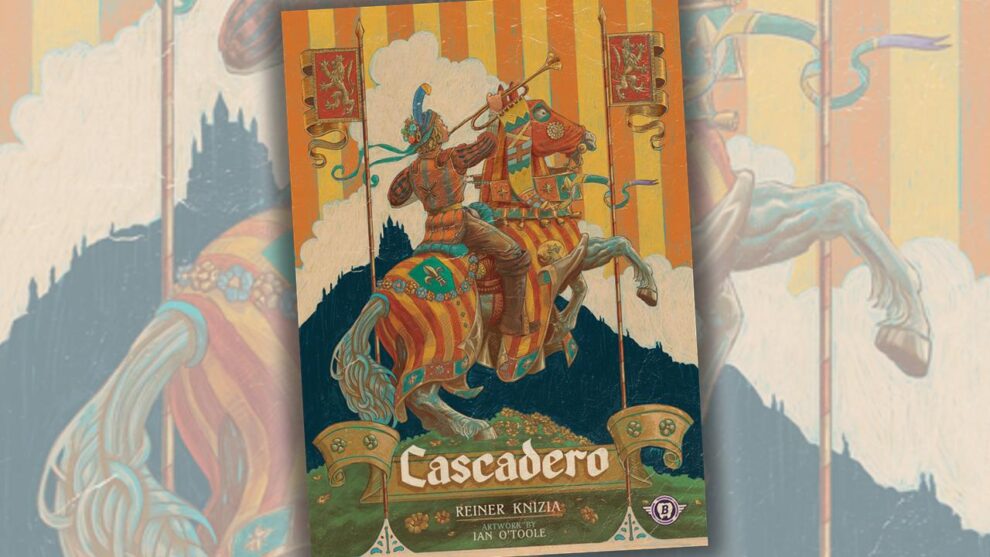




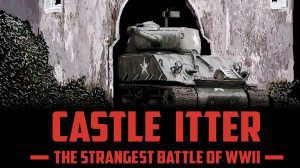




Add Comment